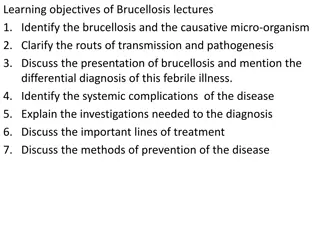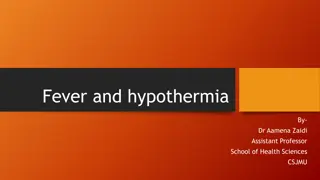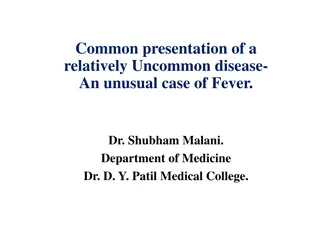Understanding Acute Rheumatic Fever: Causes, Symptoms, and Impact
Acute Rheumatic Fever (ARF) is a multisystem disease resulting from an autoimmune response to a sore throat caused by Group A beta-hemolytic Streptococci. It primarily affects children aged 5-14 years and can lead to rheumatic heart disease (RHD), which is the most common cause of heart disease in c
2 views • 48 slides
Potomac Horse Fever: Clinical Presentation and Diagnostic Plan
A 5-year-old Quarter Horse gelding presents with symptoms of colic and possible Potomac Horse Fever. Initial physical examination reveals sweating, tachycardia, and abnormal bowel sounds. The differential diagnoses include gastrointestinal infections, viral and bacterial causes. The diagnostic plan
1 views • 15 slides
Case Review: Diagnostic Dilemma in Urology - Management Approach for a Patient with Abdominal Pain and Fever
A 58-year-old man with a history of diabetes and hypertension presents with fever and abdominal pain, raising multiple differential diagnoses including symptomatic AAA, pyelonephritis, acute appendicitis, complicated urolithiasis, or diabetic ketoacidosis. The case explores clinical manifestations,
1 views • 35 slides
Mystery Case Study: 75-Year-Old Male with Fever and Altered Mental Status
A 75-year-old male with a history of multiple animal exposures presented with fever, altered mental status, headache, and diarrhea. Physical exam revealed vital signs within normal limits, and labs showed various results including negative infectious disease workup but pending further tests. Imaging
0 views • 11 slides
Understanding Enteric Fever (Typhoid Fever): Causes, Contagiousness, and Prognosis
Enteric fever, commonly known as typhoid fever, is an acute illness caused by Salmonella typhi bacteria transmitted through contaminated food or water. This fever is highly contagious, with individuals becoming carriers even after recovering. Close contact, contaminated water, and poor sanitation co
0 views • 18 slides
Understanding Ephemeral Fever/Three-Day Sickness in Cattle and Water Buffalo
Ephemeral fever (Three-Day Sickness) is an acute arthropod-borne viral disease affecting cattle and water buffalo. It is caused by the Bovine Ephemeral Fever Virus and manifests with biphasic fever, decreased milk yield, and other clinical signs. The disease has varying prevalence and can lead to hi
0 views • 7 slides
Foot and Mouth Disease: Overview, Symptoms, and Sequelae
Foot and Mouth Disease, also known as Aphthous fever, is a highly contagious viral infection affecting cloven-hoofed animals. It is characterized by the formation of vesicles and erosions in the mouth, nose, teats, and feet. The disease can cause a fall in milk yield, high fever, loss of appetite, a
1 views • 8 slides
Understanding Rickettsia: Pathogenesis, Clinical Manifestations, and Diagnosis
Rickettsia, a genus of Gram-negative bacteria transmitted by arthropods, is responsible for diseases like Rocky Mountain spotted fever. It causes symptoms such as high fever, rash, and severe headache. Laboratory diagnosis involves serology and isolation from experimental animals. Learn more about R
1 views • 9 slides
Unusual Case of Fever with Gastrointestinal Symptoms in a 22-Year-Old Patient
A 22-year-old male from Pune presents with high-grade fever, chills, myalgia, arthralgia, loose stools, and vomiting for 2 days. Past history is unremarkable, while the family history includes hypothyroidism in the mother and hypertension in the father. General examination reveals normal vital signs
0 views • 22 slides
Pediatric Case Presentation: Fever and Rash in a 3-Year-Old Patient
A 3-year-old female presented with fever, rash, cough, vomiting, diarrhea, and dyspnea. History revealed incomplete immunization and household fever cases. Physical exam showed tachycardia, respiratory distress, rash, and other symptoms. Past medical history indicated normal development and perinata
0 views • 26 slides
Understanding Fever: Causes, Assessment, and Management in Emergency Medicine
A temporary increase in core body temperature, aka fever, can be a response to various conditions, both physiological and pathological. It is a common complaint in emergency departments, with infections being a primary cause. Assessment involves looking into associated symptoms, duration, medical hi
0 views • 14 slides
Overview of Malignant Catarrhal Fever in Cattle and Other Species
Malignant catarrhal fever (MCF) is a fatal disease affecting various species, caused by two different viruses transmitted from wild animals. It is characterized by low morbidity but high mortality rates, with distinct clinical signs such as sudden death, head and eye manifestations, and intestinal i
0 views • 24 slides
Understanding Bovine Ephemeral Fever: Key Information and Insights
Bovine Ephemeral Fever, also known as Three-Day Sickness or Three-Day Fever, is an economically important arboviral disease affecting cattle and water buffalo in tropical and semitropical regions. It is caused by an arthropod-borne rhabdovirus and primarily transmitted by mosquitoes and biting midge
0 views • 19 slides
Ensuring Security in Persistent Key-Value Stores using Shielded Execution
This content discusses the challenges and solutions for securing LSM-based Key-Value stores in untrusted computing environments using Shielded Execution. It addresses the need for confidentiality, integrity, and freshness of data in persistent storage systems. The research explores Trusted Execution
0 views • 32 slides
Ignaz Semmelweis and the Fight Against Puerperal Fever
Ignaz Semmelweis, a pioneer in antiseptic procedures, determined the cause of puerperal fever in the 19th century. His work led to a significant reduction in maternal mortality by identifying the importance of handwashing in healthcare settings. Puerperal fever, a common cause of death in women afte
0 views • 29 slides
Case Study: A New Kid on the Block - Pediatric Presentation
An 11-year-old girl presented with a four-month history of fever, three months of generalized weakness and body ache, and a recent weight loss. Physical examination revealed pallor, edema, generalized tenderness, lymphadenopathy, and telangiectatic rash. Vitals showed elevated respiratory and heart
0 views • 27 slides
Understanding the Impact of African Swine Fever on China's Agriculture Sector
The outbreak of African Swine Fever (ASF) in China has had significant ramifications on the global protein industry. With mortality rates exceeding 95% and no vaccine available, the country has seen massive losses in its hog population, affecting pork supplies worldwide. Chinese authorities are taki
0 views • 13 slides
High-Performance Transactions for Persistent Memories
Explore the optimization of transactions for persistent memories, focusing on ordering constraints, synchronous vs. deferred commit transactions, persistency models, and performance evaluation. The study aims to improve transaction performance in the presence of high persistent memory latencies by m
0 views • 26 slides
Complex Case Study of Fever of Unknown Origin in a Patient with Multiple Sclerosis
A 42-year-old African American male with a history of Multiple Sclerosis presented with a fever of unknown origin, challenging the medical team to identify the underlying cause despite multiple investigations, treatments, and consultations. His complex medical history, including prior UTI treatment
0 views • 19 slides
Understanding Sore Throats and Rheumatic Fever
Learn about the impact of sore throats and rheumatic fever, particularly on Maori and Pacific families. Discover how rheumatic fever affects the body and ways to protect your whanau. Find information on treating strep throat and getting help from health workers or the Healthline. Acknowledgements to
0 views • 12 slides
Understanding Persistent Memory Use with WHISPER by University of Wisconsin-Madison & Hewlett-Packard Labs
This analysis delves into the use of persistent memory with WHISPER, uncovering behaviors, system support enhancements, and the benefits of persistent memory technology. It discusses guarantees applications need, achieving consistency, and systems tailored for persistent memory utilization, providin
1 views • 24 slides
Yellow Fever: Adverse Reactions and Risks
Yellow fever vaccination can lead to severe adverse reactions like anaphylaxis, neurotropic disease, and viscerotropic disease. These reactions can range from immediate hypersensitivity to rare but serious outcomes such as meningitis and multiple system organ failure. The mortality rate associated w
0 views • 11 slides
Challenges in Continuing Yellow Fever Activities Amid COVID-19
Challenges persist in sustaining yellow fever activities during the COVID-19 pandemic, with decreased surveillance, delayed outbreak responses, and logistical disruptions impacting efforts to eliminate yellow fever epidemics. The EYE partnership focuses on protecting at-risk populations, preventing
0 views • 9 slides
Summer Sufferings: Treatment Options for Hay Fever and Related Conditions
Dr. Craig Masson, a GP in Clarkston, East Renfrewshire, discusses prescribing and non-prescribing options for hay fever, sinusitis, prickly heat, urticaria, and Lyme disease. The content covers the challenges of managing hay fever symptoms including grass and pollen allergies, and suggests non-pharm
0 views • 24 slides
Fever Associations and Clinical Presentations in Tropical Medicine and Gastroenterology
This presentation by Dr. Amr Ahmed Hamed, a lecturer at Sohag University, explores various fever associations and clinical presentations related to tropical medicine and gastroenterology. Topics covered include fever with jaundice, sweating, rigors, hepatomegaly, splenomegaly, rash, lymphadenopathy,
0 views • 25 slides
Comprehensive Overview of Brucellosis: Causes, Transmission, Diagnosis, and Treatment
Brucellosis, also known as Malta fever or Mediterranean fever, is a systemic bacterial infection caused by Brucella species. This overview covers the identification of the disease, its transmission methods, clinical presentation, complications, diagnostic investigations, treatment options, and preve
0 views • 12 slides
Understanding Kyasanur Forest Disease: A Veterinary Perspective
Kyasanur Forest Disease (KFD) is a tick-borne viral hemorrhagic fever caused by the Flavivirus, primarily affecting monkeys and humans in certain endemic areas of India. The disease was first identified in 1957 in Karnataka and is characterized by symptoms like fever and bleeding disorders. The viru
0 views • 16 slides
Rheumatic Fever: A Comprehensive Overview of Epidemiology, Pathogenesis, and Clinical Features
Rheumatic fever is a delayed autoimmune reaction to group A, B-hemolytic streptococcal pharyngitis in genetically susceptible individuals. This condition involves the heart, joints, brain, skin, and serous surfaces. The incidence varies between developing and developed countries, with environmental
0 views • 31 slides
Epidemiology of African Swine Fever in Uganda: Insights and Challenges
African Swine Fever (ASF), caused by a large DNA virus, poses a significant threat to domestic pig populations in Uganda. Factors influencing its persistence include high mortality rates, absence of vaccines or treatments, and its endemic nature in Sub-Saharan Africa (SSA). Research aims to understa
0 views • 12 slides
Unveiling the Parable of the Persistent Widow in Luke's Gospel
Delve into the cultural context of Jesus's teachings through the lens of the Second Temple Period. Explore the Parable of the Persistent Widow in Luke, analyzing the significance of prayer, justice, and faith as portrayed in this narrative. Uncover the timeless message of perseverance and trust in d
0 views • 28 slides
Understanding Fever and Hypothermia: Body Temperature Regulation
Body temperature is the balance between heat production and heat loss, crucial for maintaining health. Fever and hypothermia are conditions where body temperature is elevated or decreased respectively. Factors like age, exercise, hormonal levels, stress, and environment can affect body temperature.
0 views • 10 slides
Understanding Tick Fever in Neonates: Symptoms, Diagnosis, Treatment, and Prevention
Tick fever in neonates is a febrile disease transmitted by tick bites, with symptoms including fever, loss of appetite, depression, weakness, red urine, anemia, and jaundice. The disease can be diagnosed through clinical symptoms, tick presence, and blood smear examination. Treatment involves medica
0 views • 9 slides
Understanding Valley Fever: Symptoms, Risks, and Prevention in California
Valley fever is a fungal illness prevalent in specific California counties, primarily affecting the lungs. From common symptoms like fatigue and cough to severe infections, learn how this disease can impact individuals differently. Discover who is at higher risk, how long symptoms can last, and prev
0 views • 17 slides
Case Study: Infant with Persistent Fever and Cry
Aditi Malakar, a 2-month-old female infant, presented with a remittent fever persisting for 9 days unresponsive to antipyretics, along with persistent crying and decreased feeding for the last 2 days. She was referred to the hospital after being diagnosed with sepsis elsewhere. Aditi had a history o
0 views • 31 slides
Case Study: 55-Year-Old Male Patient with Fever, Breathlessness, and LRTI
A 55-year-old male presented with fever, breathlessness, and a history of Dengue fever. Further investigations revealed Diabetes Mellitus and LRTI with AKI. Treatment included antibiotics and supportive care.
0 views • 16 slides
Evaluation of Low-Grade Fever and Bone Pain in a 16-Year-Old Female Patient
A 16-year-old female presented with low-grade fever and bone pain persisting for 7 months. With elevated CRP and ESR levels, a bone biopsy has been requested to investigate the underlying cause. Blood cultures and rheumatologic workup were negative, and results are pending. Further evaluation is ess
0 views • 12 slides
Understanding Persistent Pain: Challenges, Strategies, and Interventions
This collection of images and text delves into the challenges faced when treating individuals with persistent pain, covering themes like acceptance, change, and resources. It explores the bidirectional association between stress, distress, and pain, and provides insights into the complex nature of p
0 views • 28 slides
Overview of Rift Valley Fever: Symptoms in Animals and Humans
Rift Valley Fever (RVF) is an acute viral hemorrhagic fever primarily affecting domesticated animals and humans. The disease is caused by the RVF virus transmitted through mosquito bites or contact with infected animal tissues. In animals, clinical signs vary with high mortality rates in young lambs
0 views • 10 slides
Understanding Pyrexia of Unknown Origin: Causes and Classification
Pyrexia of unknown origin (PUO) is a challenging diagnostic scenario characterized by persistent fever without an identified cause. Dr. Sujeetha Chandrababu M.D. defined PUO as temperatures exceeding 38.3°C for several weeks with no definitive diagnosis. Classification of PUO includes various categ
0 views • 43 slides
Unusual Case Presentation of Fever in a Young Adult Male
A 24-year-old male student presented with a one-month history of moderate to high-grade fever. This unusual case of a prolonged fever warrants thorough investigation to identify the underlying cause.
1 views • 20 slides







































